Financial Accounting: Principles, Statements, and Analysis Report
VerifiedAdded on 2020/11/23
|28
|2966
|79
Report
AI Summary
This financial accounting report provides a comprehensive overview of financial accounting principles and their practical applications. It begins with an introduction to financial accounting, its purpose, and its importance to internal and external stakeholders. The report then delves into various aspects of accounting, including journal entries, ledgers, trial balances, and the preparation of financial statements such as the statement of profit and loss and balance sheets. It explores key concepts like consistency, prudence, and depreciation methods. Furthermore, the report covers bank reconciliation statements, control accounts, and suspense accounts, along with a discussion on the differences between financial statements prepared by sole traders and limited companies. The report uses examples from different clients to illustrate accounting practices, making it a valuable resource for students and professionals seeking to understand and apply financial accounting principles. It concludes with a summary of the key takeaways and a list of references.
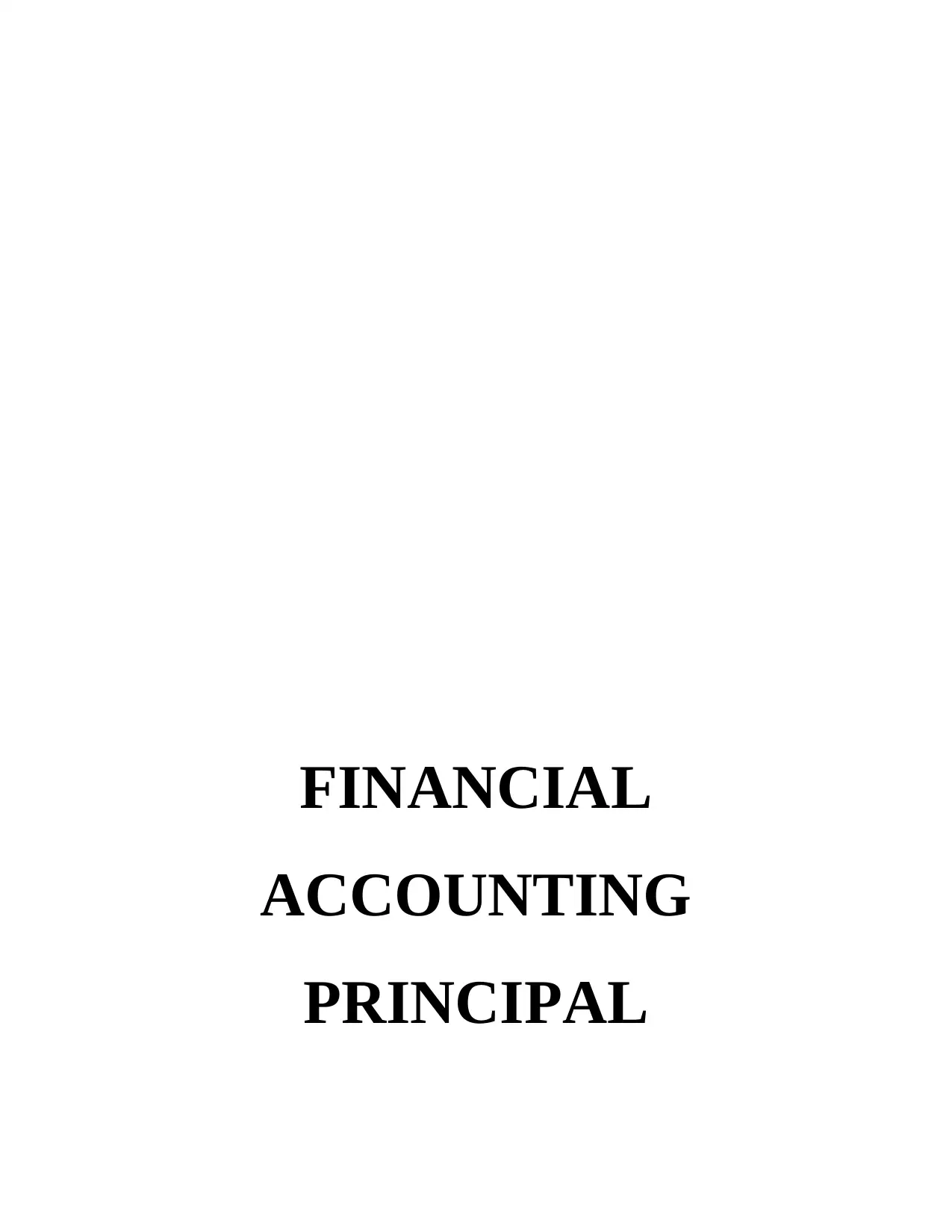
FINANCIAL
ACCOUNTING
PRINCIPAL
ACCOUNTING
PRINCIPAL
Paraphrase This Document
Need a fresh take? Get an instant paraphrase of this document with our AI Paraphraser
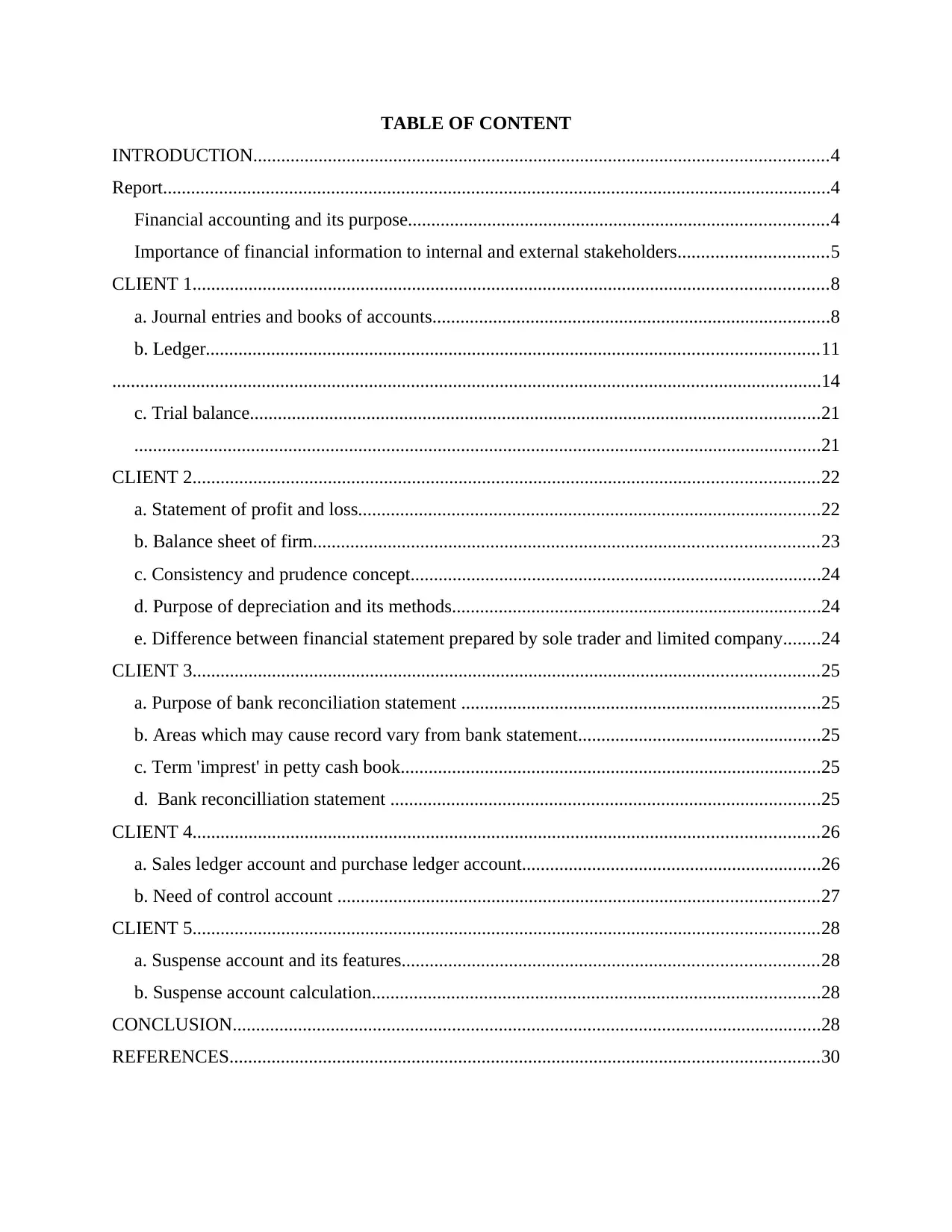
TABLE OF CONTENT
INTRODUCTION...........................................................................................................................4
Report...............................................................................................................................................4
Financial accounting and its purpose..........................................................................................4
Importance of financial information to internal and external stakeholders................................5
CLIENT 1........................................................................................................................................8
a. Journal entries and books of accounts.....................................................................................8
b. Ledger...................................................................................................................................11
........................................................................................................................................................14
c. Trial balance..........................................................................................................................21
...................................................................................................................................................21
CLIENT 2......................................................................................................................................22
a. Statement of profit and loss...................................................................................................22
b. Balance sheet of firm............................................................................................................23
c. Consistency and prudence concept........................................................................................24
d. Purpose of depreciation and its methods...............................................................................24
e. Difference between financial statement prepared by sole trader and limited company........24
CLIENT 3......................................................................................................................................25
a. Purpose of bank reconciliation statement .............................................................................25
b. Areas which may cause record vary from bank statement....................................................25
c. Term 'imprest' in petty cash book..........................................................................................25
d. Bank reconcilliation statement ............................................................................................25
CLIENT 4......................................................................................................................................26
a. Sales ledger account and purchase ledger account................................................................26
b. Need of control account .......................................................................................................27
CLIENT 5......................................................................................................................................28
a. Suspense account and its features.........................................................................................28
b. Suspense account calculation................................................................................................28
CONCLUSION..............................................................................................................................28
REFERENCES..............................................................................................................................30
INTRODUCTION...........................................................................................................................4
Report...............................................................................................................................................4
Financial accounting and its purpose..........................................................................................4
Importance of financial information to internal and external stakeholders................................5
CLIENT 1........................................................................................................................................8
a. Journal entries and books of accounts.....................................................................................8
b. Ledger...................................................................................................................................11
........................................................................................................................................................14
c. Trial balance..........................................................................................................................21
...................................................................................................................................................21
CLIENT 2......................................................................................................................................22
a. Statement of profit and loss...................................................................................................22
b. Balance sheet of firm............................................................................................................23
c. Consistency and prudence concept........................................................................................24
d. Purpose of depreciation and its methods...............................................................................24
e. Difference between financial statement prepared by sole trader and limited company........24
CLIENT 3......................................................................................................................................25
a. Purpose of bank reconciliation statement .............................................................................25
b. Areas which may cause record vary from bank statement....................................................25
c. Term 'imprest' in petty cash book..........................................................................................25
d. Bank reconcilliation statement ............................................................................................25
CLIENT 4......................................................................................................................................26
a. Sales ledger account and purchase ledger account................................................................26
b. Need of control account .......................................................................................................27
CLIENT 5......................................................................................................................................28
a. Suspense account and its features.........................................................................................28
b. Suspense account calculation................................................................................................28
CONCLUSION..............................................................................................................................28
REFERENCES..............................................................................................................................30
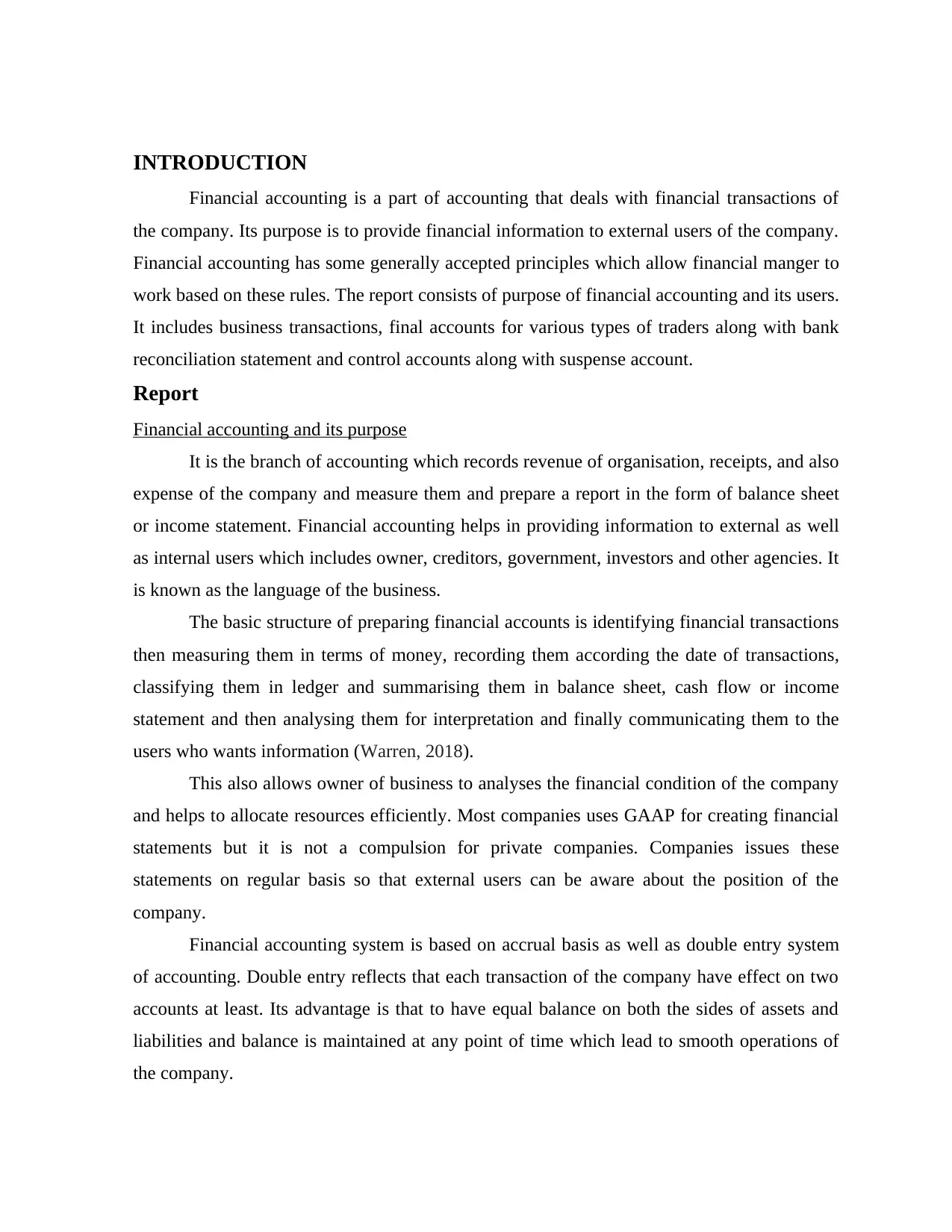
INTRODUCTION
Financial accounting is a part of accounting that deals with financial transactions of
the company. Its purpose is to provide financial information to external users of the company.
Financial accounting has some generally accepted principles which allow financial manger to
work based on these rules. The report consists of purpose of financial accounting and its users.
It includes business transactions, final accounts for various types of traders along with bank
reconciliation statement and control accounts along with suspense account.
Report
Financial accounting and its purpose
It is the branch of accounting which records revenue of organisation, receipts, and also
expense of the company and measure them and prepare a report in the form of balance sheet
or income statement. Financial accounting helps in providing information to external as well
as internal users which includes owner, creditors, government, investors and other agencies. It
is known as the language of the business.
The basic structure of preparing financial accounts is identifying financial transactions
then measuring them in terms of money, recording them according the date of transactions,
classifying them in ledger and summarising them in balance sheet, cash flow or income
statement and then analysing them for interpretation and finally communicating them to the
users who wants information (Warren, 2018).
This also allows owner of business to analyses the financial condition of the company
and helps to allocate resources efficiently. Most companies uses GAAP for creating financial
statements but it is not a compulsion for private companies. Companies issues these
statements on regular basis so that external users can be aware about the position of the
company.
Financial accounting system is based on accrual basis as well as double entry system
of accounting. Double entry reflects that each transaction of the company have effect on two
accounts at least. Its advantage is that to have equal balance on both the sides of assets and
liabilities and balance is maintained at any point of time which lead to smooth operations of
the company.
Financial accounting is a part of accounting that deals with financial transactions of
the company. Its purpose is to provide financial information to external users of the company.
Financial accounting has some generally accepted principles which allow financial manger to
work based on these rules. The report consists of purpose of financial accounting and its users.
It includes business transactions, final accounts for various types of traders along with bank
reconciliation statement and control accounts along with suspense account.
Report
Financial accounting and its purpose
It is the branch of accounting which records revenue of organisation, receipts, and also
expense of the company and measure them and prepare a report in the form of balance sheet
or income statement. Financial accounting helps in providing information to external as well
as internal users which includes owner, creditors, government, investors and other agencies. It
is known as the language of the business.
The basic structure of preparing financial accounts is identifying financial transactions
then measuring them in terms of money, recording them according the date of transactions,
classifying them in ledger and summarising them in balance sheet, cash flow or income
statement and then analysing them for interpretation and finally communicating them to the
users who wants information (Warren, 2018).
This also allows owner of business to analyses the financial condition of the company
and helps to allocate resources efficiently. Most companies uses GAAP for creating financial
statements but it is not a compulsion for private companies. Companies issues these
statements on regular basis so that external users can be aware about the position of the
company.
Financial accounting system is based on accrual basis as well as double entry system
of accounting. Double entry reflects that each transaction of the company have effect on two
accounts at least. Its advantage is that to have equal balance on both the sides of assets and
liabilities and balance is maintained at any point of time which lead to smooth operations of
the company.
⊘ This is a preview!⊘
Do you want full access?
Subscribe today to unlock all pages.

Trusted by 1+ million students worldwide
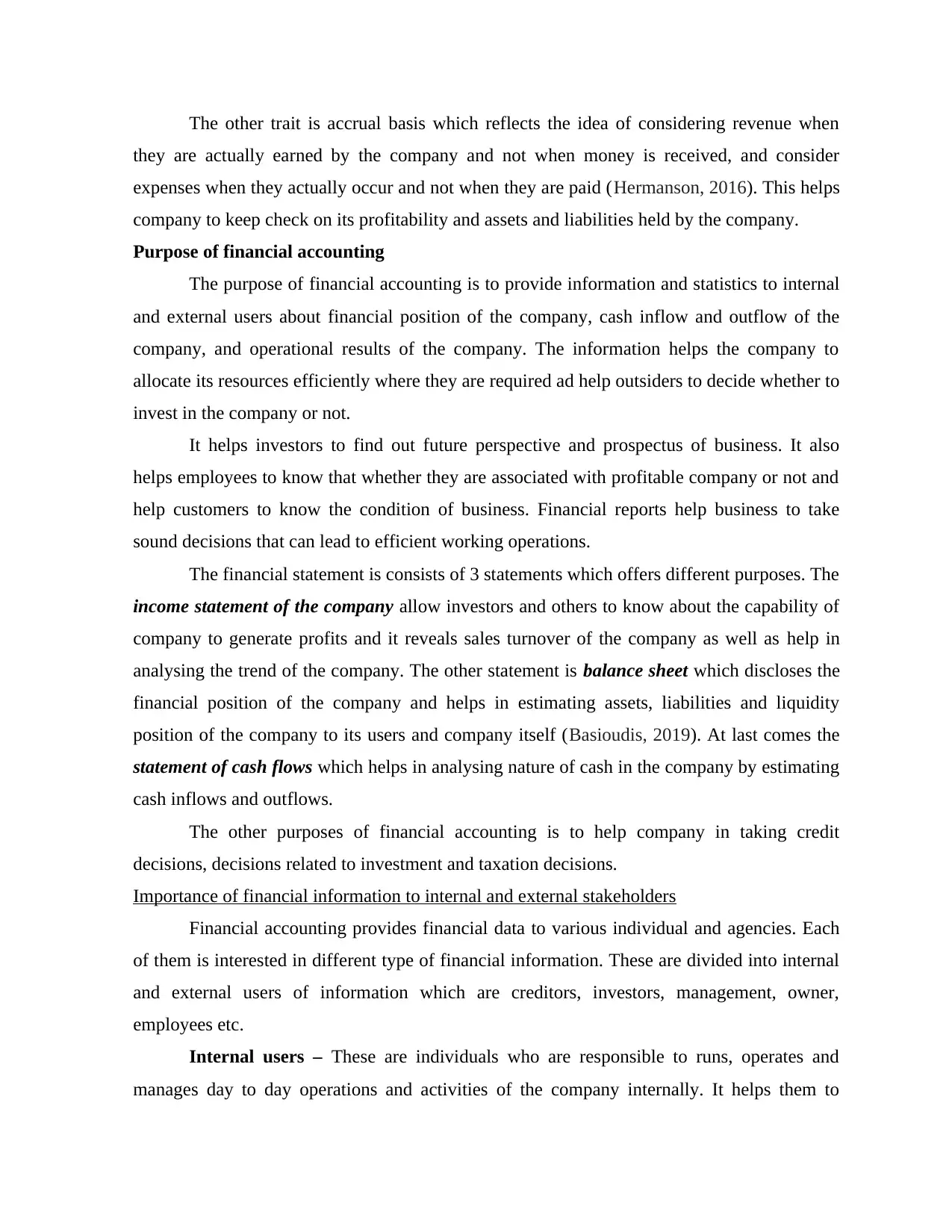
The other trait is accrual basis which reflects the idea of considering revenue when
they are actually earned by the company and not when money is received, and consider
expenses when they actually occur and not when they are paid (Hermanson, 2016). This helps
company to keep check on its profitability and assets and liabilities held by the company.
Purpose of financial accounting
The purpose of financial accounting is to provide information and statistics to internal
and external users about financial position of the company, cash inflow and outflow of the
company, and operational results of the company. The information helps the company to
allocate its resources efficiently where they are required ad help outsiders to decide whether to
invest in the company or not.
It helps investors to find out future perspective and prospectus of business. It also
helps employees to know that whether they are associated with profitable company or not and
help customers to know the condition of business. Financial reports help business to take
sound decisions that can lead to efficient working operations.
The financial statement is consists of 3 statements which offers different purposes. The
income statement of the company allow investors and others to know about the capability of
company to generate profits and it reveals sales turnover of the company as well as help in
analysing the trend of the company. The other statement is balance sheet which discloses the
financial position of the company and helps in estimating assets, liabilities and liquidity
position of the company to its users and company itself (Basioudis, 2019). At last comes the
statement of cash flows which helps in analysing nature of cash in the company by estimating
cash inflows and outflows.
The other purposes of financial accounting is to help company in taking credit
decisions, decisions related to investment and taxation decisions.
Importance of financial information to internal and external stakeholders
Financial accounting provides financial data to various individual and agencies. Each
of them is interested in different type of financial information. These are divided into internal
and external users of information which are creditors, investors, management, owner,
employees etc.
Internal users – These are individuals who are responsible to runs, operates and
manages day to day operations and activities of the company internally. It helps them to
they are actually earned by the company and not when money is received, and consider
expenses when they actually occur and not when they are paid (Hermanson, 2016). This helps
company to keep check on its profitability and assets and liabilities held by the company.
Purpose of financial accounting
The purpose of financial accounting is to provide information and statistics to internal
and external users about financial position of the company, cash inflow and outflow of the
company, and operational results of the company. The information helps the company to
allocate its resources efficiently where they are required ad help outsiders to decide whether to
invest in the company or not.
It helps investors to find out future perspective and prospectus of business. It also
helps employees to know that whether they are associated with profitable company or not and
help customers to know the condition of business. Financial reports help business to take
sound decisions that can lead to efficient working operations.
The financial statement is consists of 3 statements which offers different purposes. The
income statement of the company allow investors and others to know about the capability of
company to generate profits and it reveals sales turnover of the company as well as help in
analysing the trend of the company. The other statement is balance sheet which discloses the
financial position of the company and helps in estimating assets, liabilities and liquidity
position of the company to its users and company itself (Basioudis, 2019). At last comes the
statement of cash flows which helps in analysing nature of cash in the company by estimating
cash inflows and outflows.
The other purposes of financial accounting is to help company in taking credit
decisions, decisions related to investment and taxation decisions.
Importance of financial information to internal and external stakeholders
Financial accounting provides financial data to various individual and agencies. Each
of them is interested in different type of financial information. These are divided into internal
and external users of information which are creditors, investors, management, owner,
employees etc.
Internal users – These are individuals who are responsible to runs, operates and
manages day to day operations and activities of the company internally. It helps them to
Paraphrase This Document
Need a fresh take? Get an instant paraphrase of this document with our AI Paraphraser
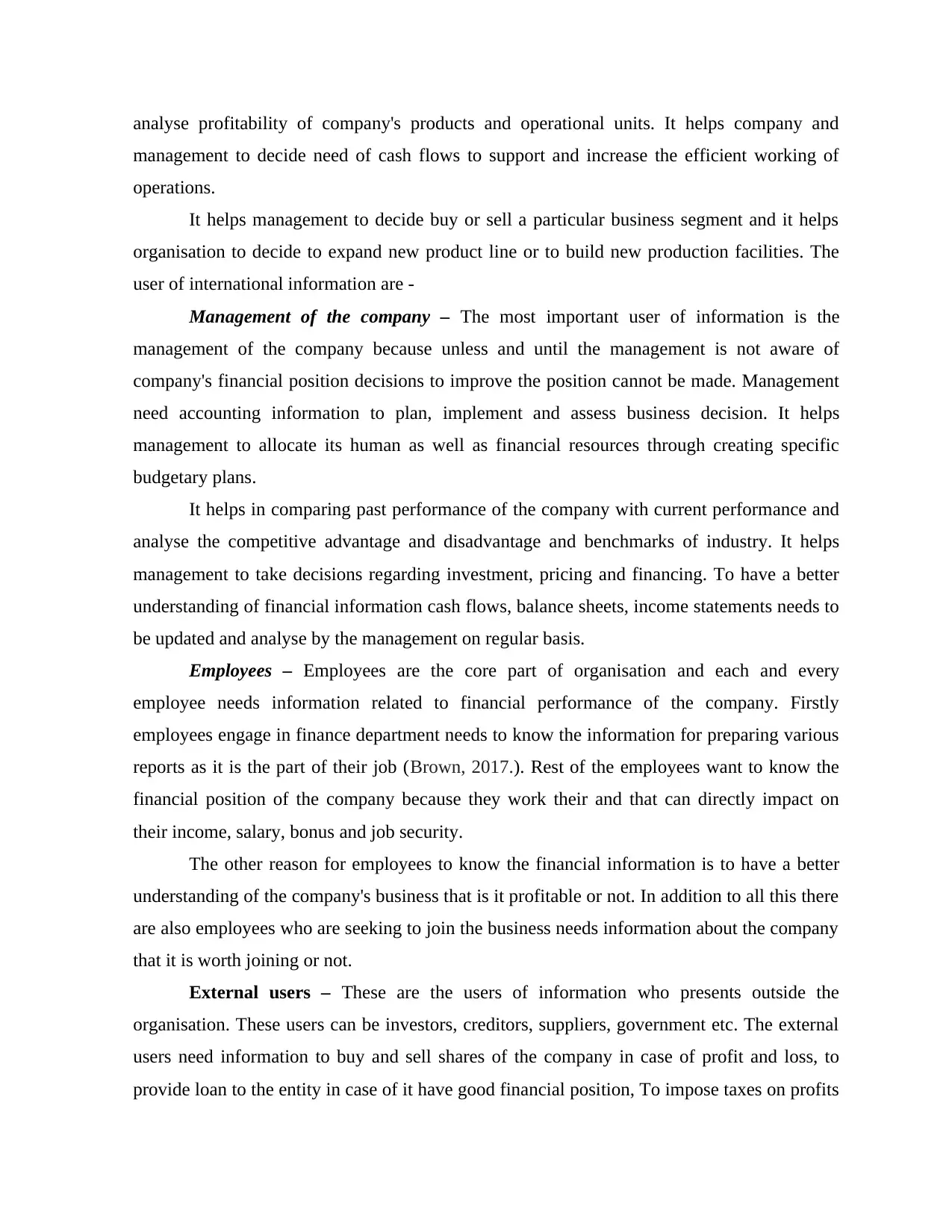
analyse profitability of company's products and operational units. It helps company and
management to decide need of cash flows to support and increase the efficient working of
operations.
It helps management to decide buy or sell a particular business segment and it helps
organisation to decide to expand new product line or to build new production facilities. The
user of international information are -
Management of the company – The most important user of information is the
management of the company because unless and until the management is not aware of
company's financial position decisions to improve the position cannot be made. Management
need accounting information to plan, implement and assess business decision. It helps
management to allocate its human as well as financial resources through creating specific
budgetary plans.
It helps in comparing past performance of the company with current performance and
analyse the competitive advantage and disadvantage and benchmarks of industry. It helps
management to take decisions regarding investment, pricing and financing. To have a better
understanding of financial information cash flows, balance sheets, income statements needs to
be updated and analyse by the management on regular basis.
Employees – Employees are the core part of organisation and each and every
employee needs information related to financial performance of the company. Firstly
employees engage in finance department needs to know the information for preparing various
reports as it is the part of their job (Brown, 2017.). Rest of the employees want to know the
financial position of the company because they work their and that can directly impact on
their income, salary, bonus and job security.
The other reason for employees to know the financial information is to have a better
understanding of the company's business that is it profitable or not. In addition to all this there
are also employees who are seeking to join the business needs information about the company
that it is worth joining or not.
External users – These are the users of information who presents outside the
organisation. These users can be investors, creditors, suppliers, government etc. The external
users need information to buy and sell shares of the company in case of profit and loss, to
provide loan to the entity in case of it have good financial position, To impose taxes on profits
management to decide need of cash flows to support and increase the efficient working of
operations.
It helps management to decide buy or sell a particular business segment and it helps
organisation to decide to expand new product line or to build new production facilities. The
user of international information are -
Management of the company – The most important user of information is the
management of the company because unless and until the management is not aware of
company's financial position decisions to improve the position cannot be made. Management
need accounting information to plan, implement and assess business decision. It helps
management to allocate its human as well as financial resources through creating specific
budgetary plans.
It helps in comparing past performance of the company with current performance and
analyse the competitive advantage and disadvantage and benchmarks of industry. It helps
management to take decisions regarding investment, pricing and financing. To have a better
understanding of financial information cash flows, balance sheets, income statements needs to
be updated and analyse by the management on regular basis.
Employees – Employees are the core part of organisation and each and every
employee needs information related to financial performance of the company. Firstly
employees engage in finance department needs to know the information for preparing various
reports as it is the part of their job (Brown, 2017.). Rest of the employees want to know the
financial position of the company because they work their and that can directly impact on
their income, salary, bonus and job security.
The other reason for employees to know the financial information is to have a better
understanding of the company's business that is it profitable or not. In addition to all this there
are also employees who are seeking to join the business needs information about the company
that it is worth joining or not.
External users – These are the users of information who presents outside the
organisation. These users can be investors, creditors, suppliers, government etc. The external
users need information to buy and sell shares of the company in case of profit and loss, to
provide loan to the entity in case of it have good financial position, To impose taxes on profits
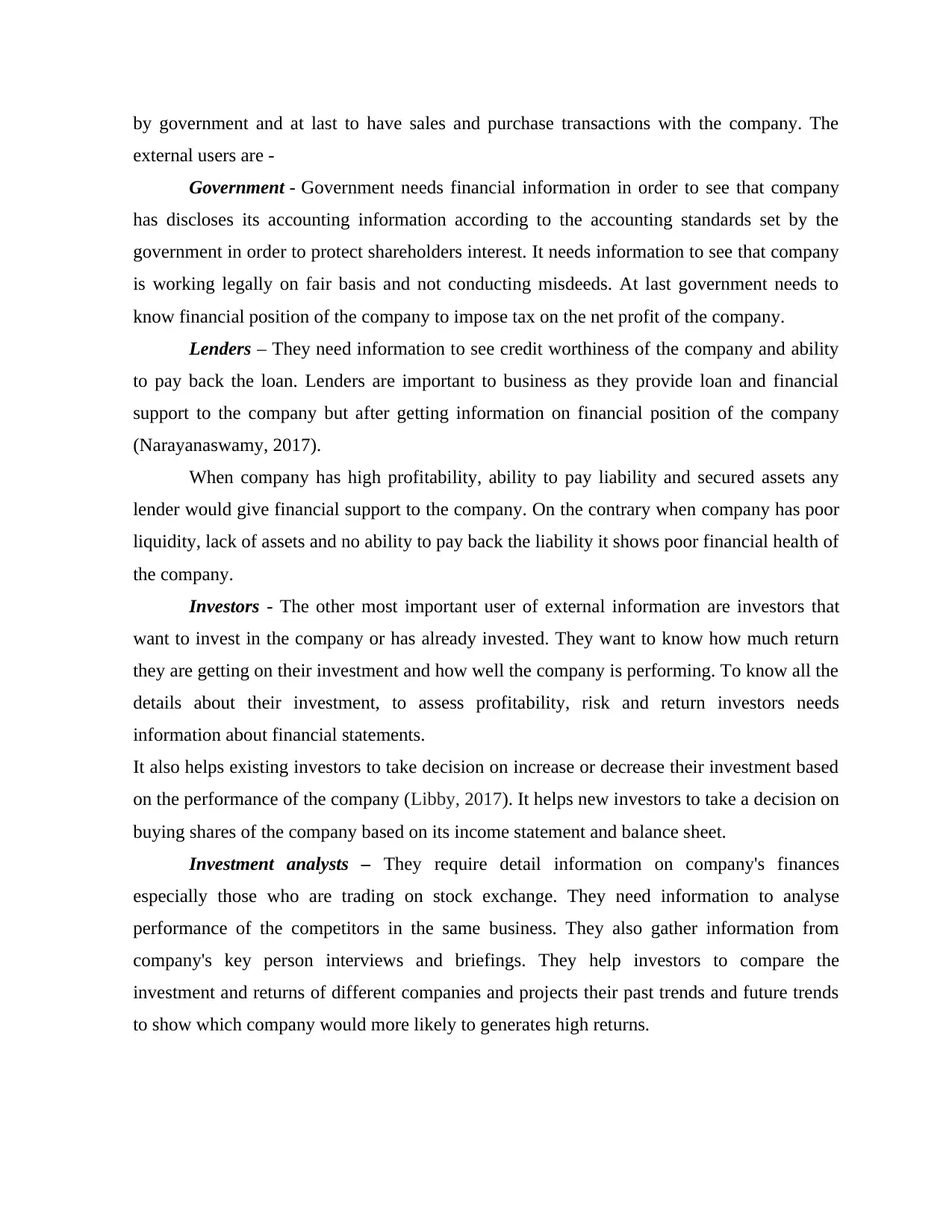
by government and at last to have sales and purchase transactions with the company. The
external users are -
Government - Government needs financial information in order to see that company
has discloses its accounting information according to the accounting standards set by the
government in order to protect shareholders interest. It needs information to see that company
is working legally on fair basis and not conducting misdeeds. At last government needs to
know financial position of the company to impose tax on the net profit of the company.
Lenders – They need information to see credit worthiness of the company and ability
to pay back the loan. Lenders are important to business as they provide loan and financial
support to the company but after getting information on financial position of the company
(Narayanaswamy, 2017).
When company has high profitability, ability to pay liability and secured assets any
lender would give financial support to the company. On the contrary when company has poor
liquidity, lack of assets and no ability to pay back the liability it shows poor financial health of
the company.
Investors - The other most important user of external information are investors that
want to invest in the company or has already invested. They want to know how much return
they are getting on their investment and how well the company is performing. To know all the
details about their investment, to assess profitability, risk and return investors needs
information about financial statements.
It also helps existing investors to take decision on increase or decrease their investment based
on the performance of the company (Libby, 2017). It helps new investors to take a decision on
buying shares of the company based on its income statement and balance sheet.
Investment analysts – They require detail information on company's finances
especially those who are trading on stock exchange. They need information to analyse
performance of the competitors in the same business. They also gather information from
company's key person interviews and briefings. They help investors to compare the
investment and returns of different companies and projects their past trends and future trends
to show which company would more likely to generates high returns.
external users are -
Government - Government needs financial information in order to see that company
has discloses its accounting information according to the accounting standards set by the
government in order to protect shareholders interest. It needs information to see that company
is working legally on fair basis and not conducting misdeeds. At last government needs to
know financial position of the company to impose tax on the net profit of the company.
Lenders – They need information to see credit worthiness of the company and ability
to pay back the loan. Lenders are important to business as they provide loan and financial
support to the company but after getting information on financial position of the company
(Narayanaswamy, 2017).
When company has high profitability, ability to pay liability and secured assets any
lender would give financial support to the company. On the contrary when company has poor
liquidity, lack of assets and no ability to pay back the liability it shows poor financial health of
the company.
Investors - The other most important user of external information are investors that
want to invest in the company or has already invested. They want to know how much return
they are getting on their investment and how well the company is performing. To know all the
details about their investment, to assess profitability, risk and return investors needs
information about financial statements.
It also helps existing investors to take decision on increase or decrease their investment based
on the performance of the company (Libby, 2017). It helps new investors to take a decision on
buying shares of the company based on its income statement and balance sheet.
Investment analysts – They require detail information on company's finances
especially those who are trading on stock exchange. They need information to analyse
performance of the competitors in the same business. They also gather information from
company's key person interviews and briefings. They help investors to compare the
investment and returns of different companies and projects their past trends and future trends
to show which company would more likely to generates high returns.
⊘ This is a preview!⊘
Do you want full access?
Subscribe today to unlock all pages.

Trusted by 1+ million students worldwide
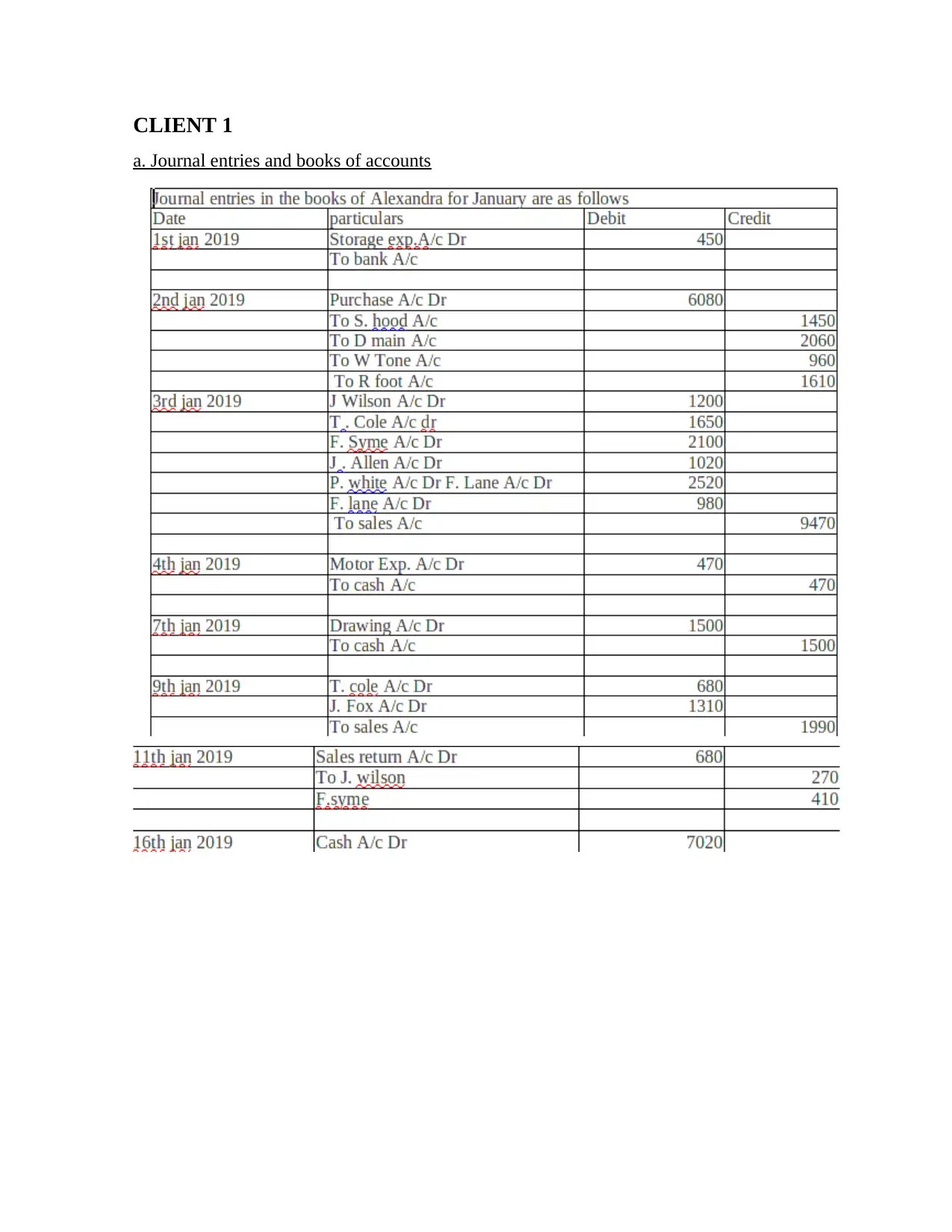
CLIENT 1
a. Journal entries and books of accounts
a. Journal entries and books of accounts
Paraphrase This Document
Need a fresh take? Get an instant paraphrase of this document with our AI Paraphraser
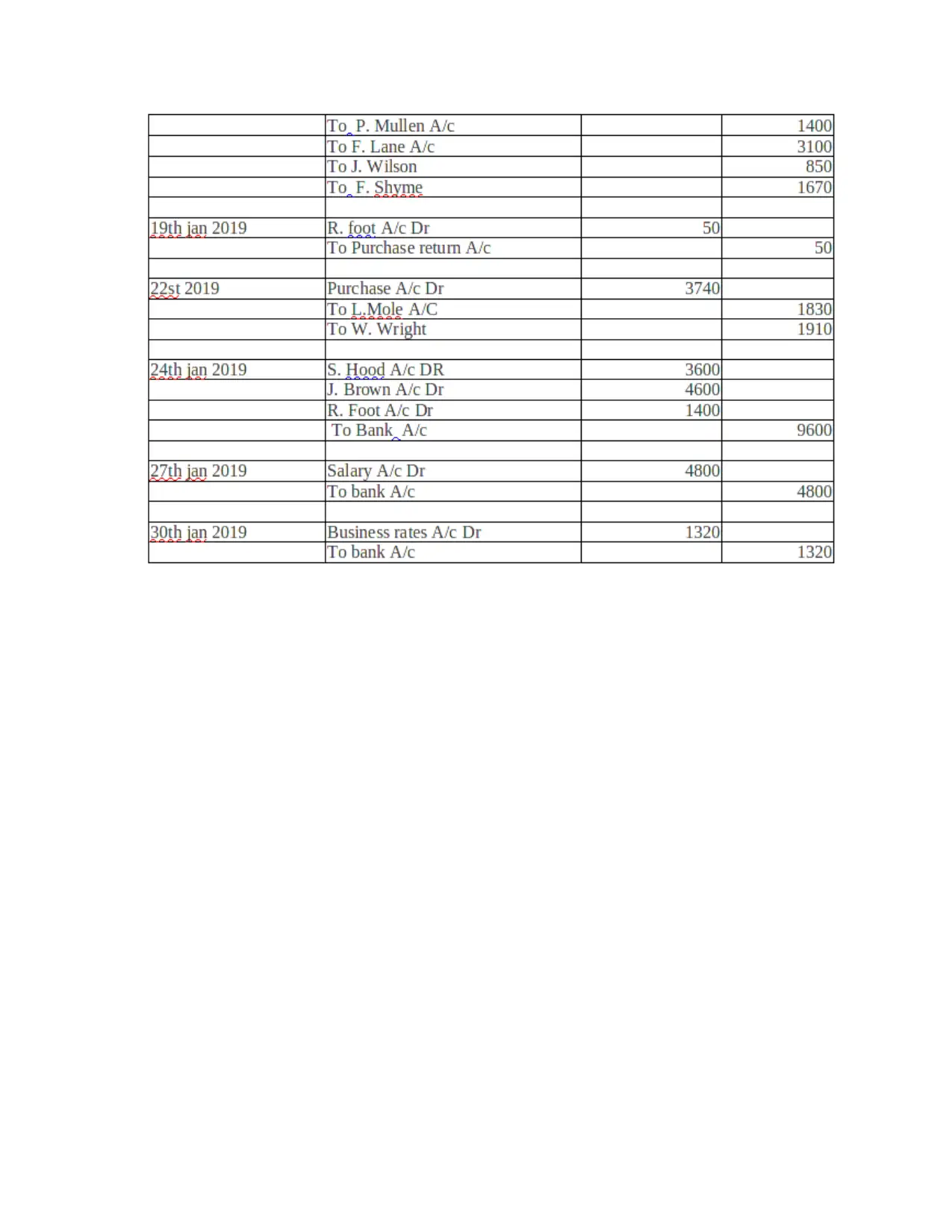
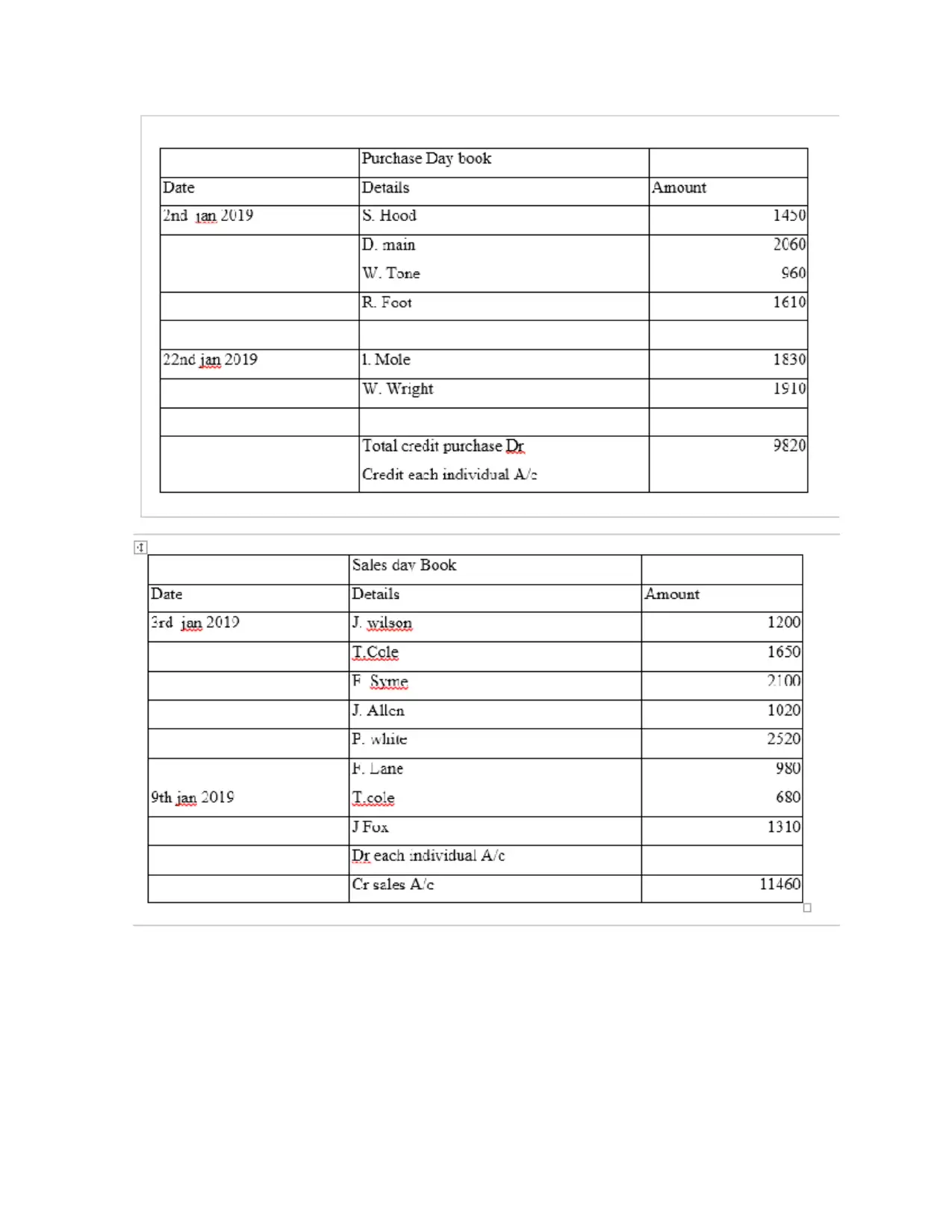
⊘ This is a preview!⊘
Do you want full access?
Subscribe today to unlock all pages.

Trusted by 1+ million students worldwide
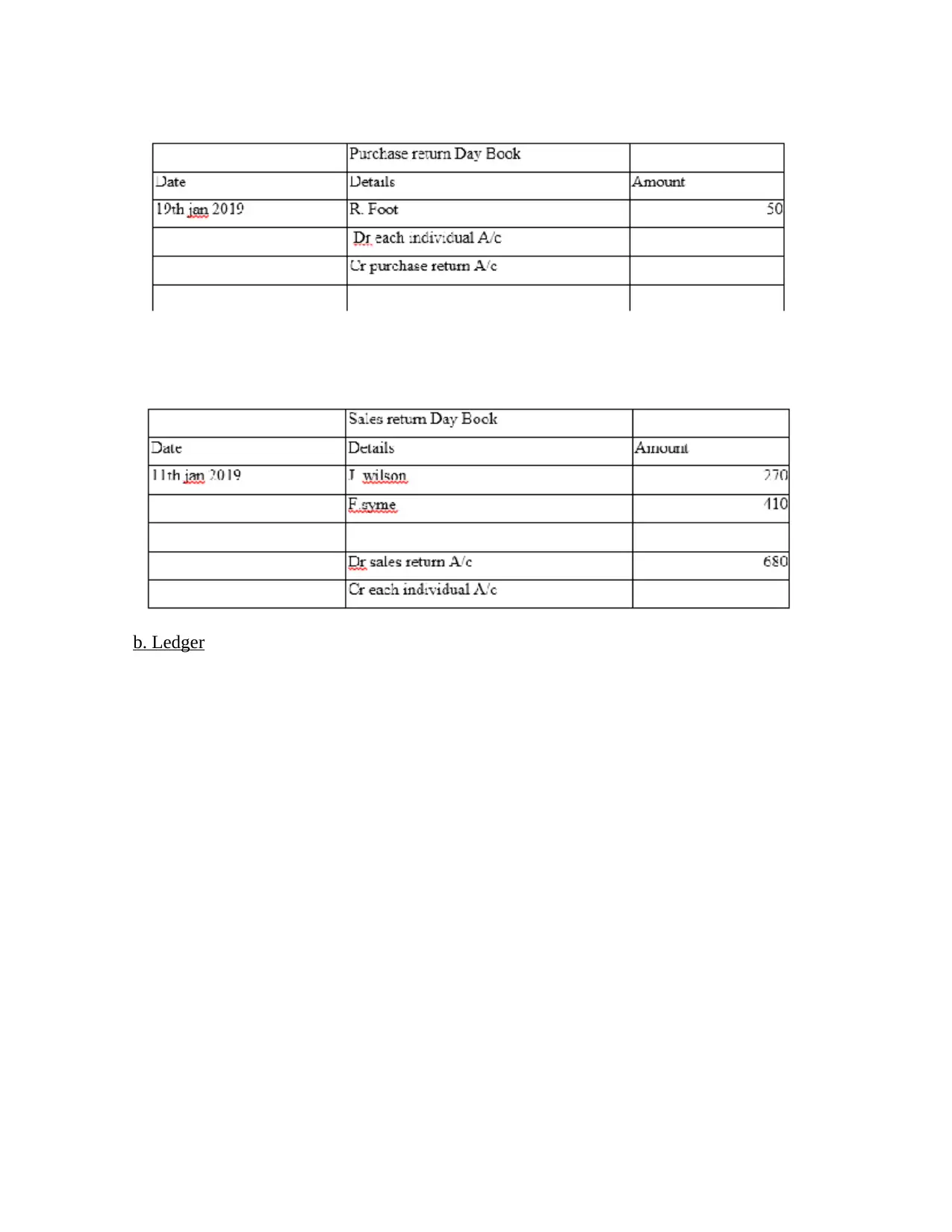
b. Ledger
Paraphrase This Document
Need a fresh take? Get an instant paraphrase of this document with our AI Paraphraser
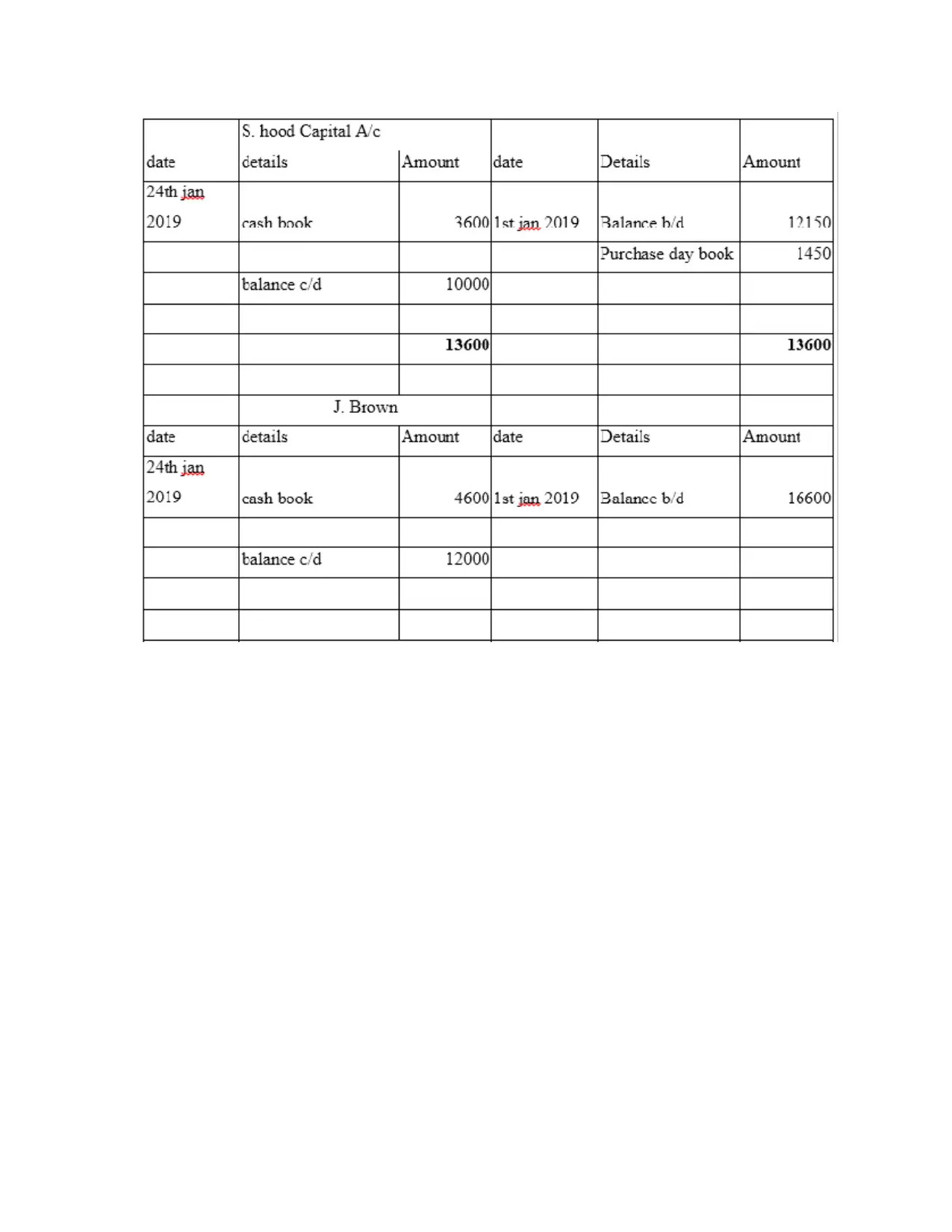
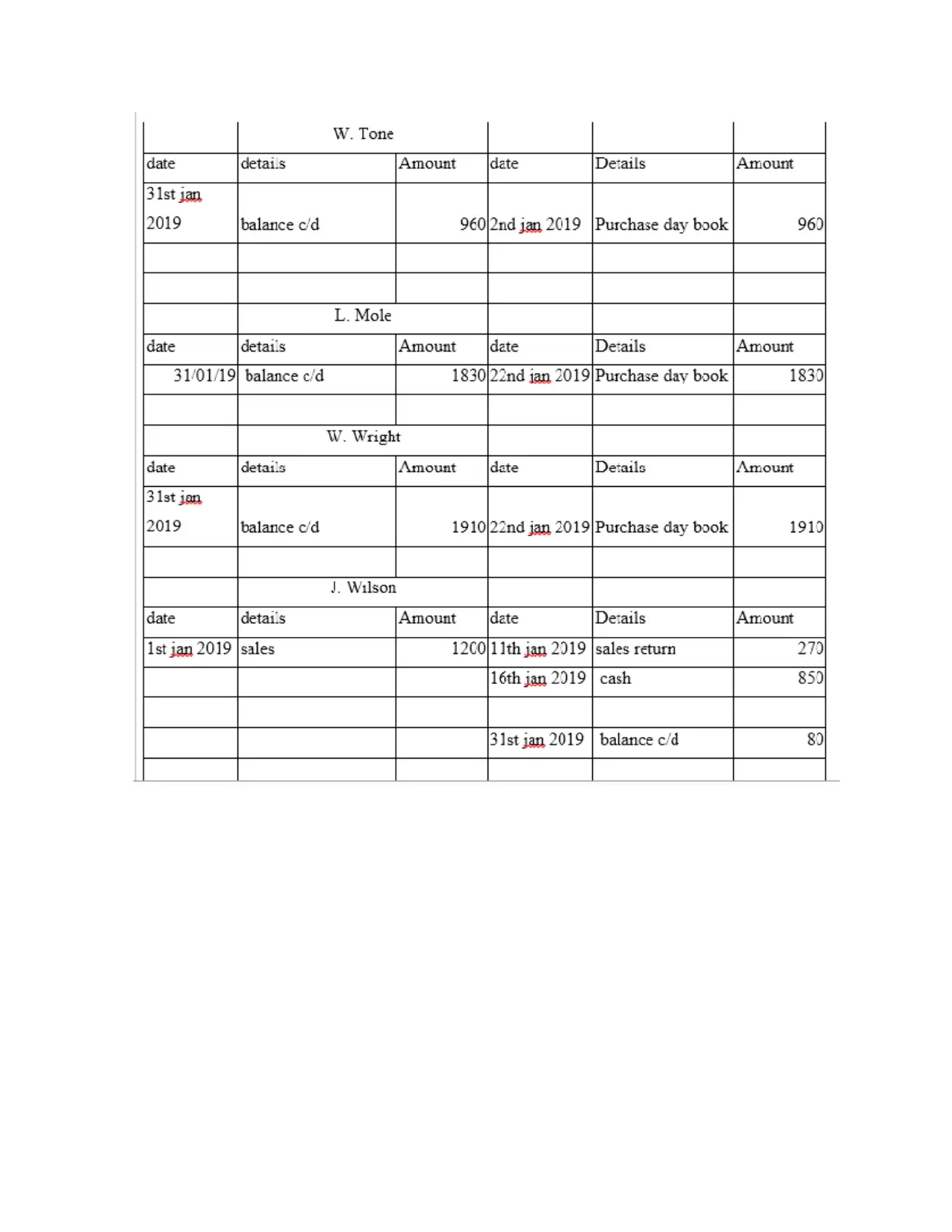
⊘ This is a preview!⊘
Do you want full access?
Subscribe today to unlock all pages.

Trusted by 1+ million students worldwide
1 out of 28
Related Documents
Your All-in-One AI-Powered Toolkit for Academic Success.
+13062052269
info@desklib.com
Available 24*7 on WhatsApp / Email
![[object Object]](/_next/static/media/star-bottom.7253800d.svg)
Unlock your academic potential
Copyright © 2020–2025 A2Z Services. All Rights Reserved. Developed and managed by ZUCOL.





